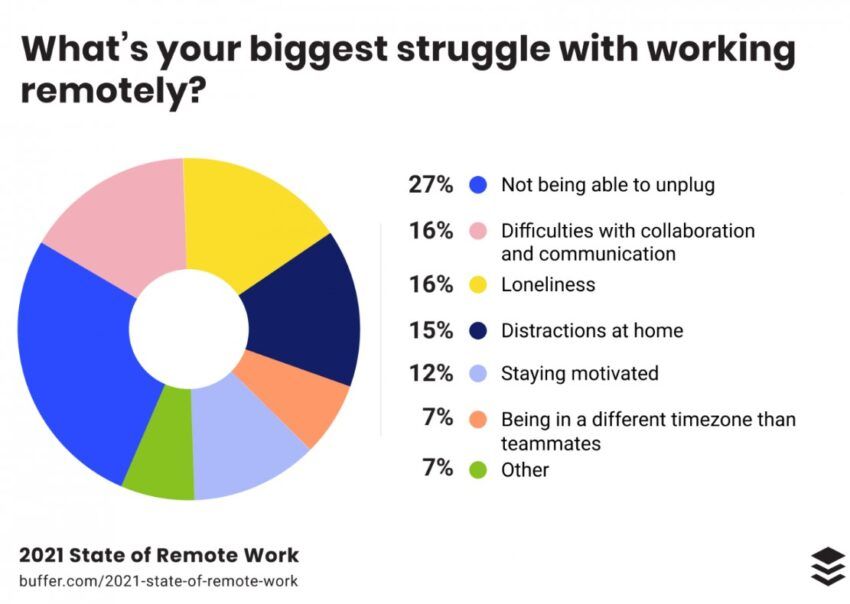The number of teams working remotely has surged in recent years, thanks to technological advances and changes in the modern workplace, as well as the recent pandemic. However, effectively managing remote employees presents unique challenges. This includes the critical aspects of screening and, when necessary, firing remote employees.
Remote work doesn’t suit everyone; some individuals may thrive in a remote environment, while others may struggle. It falls on the management to evaluate and identify those who may not adapt or align with the company’s objectives.
- Common challenges in managing remote employees
- Are you receiving a lot of irrelevant candidates for a job?
- Screening remote employees
- Find your perfect match
- Managing remote employee performance
- Terminating remote employees gracefully
- Cornerstones of employee success: screening and firing
- Frequently asked questions
Common challenges in managing remote employees
Managing remote employees presents a set of common challenges that organizations must deal with. While in traditional in-person working environments, interactions and collaboration provide an easier workflow, remote teams must find ways to navigate through daily work without these facilities.

These challenges include maintaining clear communication, ensuring productivity and accountability, and fostering a sense of belonging among remote team members.
Overcoming these hurdles requires proactive efforts from both employers and employees. First, companies should have in place all the necessary tools to deal with these challenges. There might be tools to facilitate long-distance communication and collaboration, establish clear expectations, and implement performance metrics that account for freelance job dynamics.
Are you receiving a lot of irrelevant candidates for a job?
Screening remote employees
Screening remote employees effectively is the first step in building a successful remote workforce. Following a structured approach is essential to ensure you make the right hiring decisions. Here’s a look at some important tips.
Tip 1: Define clear job roles and expectations
A less obvious challenge of managing a team long-distance is having a clear work purpose, especially for newcomers. Companies that escalate fast and have many new hires might lose sight of why an employee was hired in the first place. Arina Koganelok, HRD at BeInCrypto, shared that having a purpose helped her when she first started working in web3:
“Every time I got lost in a task or a large flow of information, this goal helped me not to lose focus and to set priorities correctly.”
Arina Koganelok
Defining job roles and expectations for remote positions helps candidates understand their responsibilities and sets the foundation for a successful working relationship. When job roles and expectations are well-defined, it becomes easier to identify the skills and qualities necessary for a candidate to thrive in a digital nomad position.
During the hiring process, recruiters and HR experts should create detailed job descriptions that outline the role’s responsibilities, goals, and key performance indicators. This not only helps attract candidates who align with the job but also serves as a foundation for evaluating their qualifications during the screening process.
Tip 2: Conduct thorough virtual interviews
Conducting thorough virtual interviews is critical to the remote employee screening process. Video interviews allow employers to assess a candidate’s communication skills, ability to adapt to remote technology and overall suitability for remote work. During these interviews, employers should ask targeted questions to gauge a candidate’s experience with remote jobs, problem-solving abilities, and self-discipline.
Additionally, virtual interviews provide an opportunity to assess cultural fit and soft skills, such as teamwork and adaptability, which are crucial in a remote work environment in both centralized and decentralized companies. To ensure the effectiveness of virtual interviews, hiring managers and recruiters should establish a structured interview process and involve key team members to gather diverse perspectives.
Pro tip
It can be difficult to understand if a person is the right fit for a job when interviewing online. Arina Koganelok, HR director at BeInCrypto, recommends tapping into personal intuition:
“When you conduct an interview remotely, it’s hard to evaluate a candidate. There is no way to “feel” a person. I believe in professional intuition, which turns on much faster during a live interview.”
Tip 3: Assess remote work skills and adaptability
Companies should consider assessing candidates’ remote work skills and adaptability during the screening process. Look for self-motivated, organized individuals who are capable of managing their time effectively.
Checking references and background is equally important, as it helps verify a candidate’s qualifications and track record. For instance, contacting previous employers and colleagues can provide valuable insights into a candidate’s work ethic, teamwork, and overall performance. You can ask specific questions about the candidate’s remote work abilities, such as their communication skills, ability to meet deadlines, and reliability.
Tip 4: Onboarding for success
Invest in a comprehensive onboarding process to set remote employees up for success. Providing the necessary training, access to remote tools, and clear guidelines for remote work practices ensures a smooth transition into their roles.
Establishing a strong foundation during the onboarding process not only helps remote employees become productive quickly but also fosters a sense of belonging and commitment to the organization. Assign mentors or buddies also help new hires acclimate to the company and navigate the remote work environment.
Find your perfect match
Managing remote employee performance

Effectively managing remote employee performance is an ongoing process. According to Julia Motorina, HR team lead at BeInCrypto, by hiring candidates with specific skills, long-distance management becomes easier:
“For me, it’s to be able to find people whom I can trust, who are independent and self-driven. So, speaking about the team, if I’m setting the goals and providing them with the necessary resources — they’re performing well without me micromanaging them, it’s more about coaching.”
Julia Motorina, HR team lead, BeInCrypto
However, evaluating performance is still equally important. Here are some tips on how to manage remote employees’ performance effectively.
Tip 1: Set clear performance metrics and goals
Setting clear performance metrics and goals is the foundation of remote performance management. This can come on an individual level and a collective level. These metrics should be specific, measurable, and aligned with the company’s objectives. At BeInCrypto, the HR team works with KPIs (key performance indicators).
“Each of my employees has a plan for the year, broken down by quarters and a detailed plan for the next quarter, plus a plan for the month with priorities set. To create such a plan, we gather as a team four to five times — we pitch ideas, divide them by people, by months, then compare our plans with the company’s goals and other departments.”
Arina Koganelok, HR director BeInCrypto
Arina also adds that providing employees with an overview of the company’s and each department’s goals and objectives helps individuals better understand their role as part of a broader spectrum.
Tip 2: Regularly communicate and provide feedback

If you should choose just one objective to work on while managing remote teams, it should be communication. Regular communication and feedback are vital in a remote work environment. Employers should establish frequent check-ins to discuss progress, provide guidance, and address remote employees’ concerns or challenges. Arina shares how she’s done with her team:
“Every Monday, we gathered and discussed the progress over the past week, plans for the next one, and problems that arose along the way. This format and, most importantly its regularity, helped me to keep up with the workload and the company’s rhythm.”
Arina Koganelok, HR director BeInCrypto
Tip 3: Leverage remote work tools
Leveraging remote work tools is essential for monitoring and improving performance. Utilize project management software, communication platforms, and time-tracking tools to facilitate collaboration and productivity. At BeInCrypto, the HR team works with an HR system that serves as an all-in-one tool:
“Each employee has their own personal profile and colleagues can find all the information they need there — contacts, questions to ask, position, education, etc. A manager, for instance, has access to more data. They can see documents, the history of an employee’s career and salary changes, can set tasks and see the dynamics of their execution. The same system helps us to set KPIs, track efficiency and record the agreements of each 1:1 with an employee.”
Arina Koganelok, HR director BeInCrypto
Tip 4: Address performance issues promptly
Performance issues need to be addressed as soon as they’re identified. When issues are left unaddressed, they can escalate, impacting productivity and team morale. Managers should monitor performance metrics and be vigilant in identifying early signs of underperformance.
Be proactive in identifying problems and offering support to help employees overcome obstacles when needed. Moreover, recognizing and rewarding success, whether through incentives, promotions, or acknowledgment, motivates remote employees to excel in their roles.
Terminating remote employees gracefully

Implementing all the above tips still doesn’t guarantee success or employee productivity. Even after adjustments and implementation, some employees might still face performance issues. Then, there might be the decision to let them go.
Terminating an employee’s contract is a significant decision that should be considered carefully. Companies should consider various factors and follow a structured process to determine when to terminate an employee’s contract is appropriate.
Tip 1: Document performance issues
Documenting performance issues records the employee’s shortcomings and demonstrates that the termination decision is based on legitimate reasons. This documentation not only helps justify the termination but also serves as a reference for discussions during the termination meeting and clarifies any inquiries that may arise during the fateful meeting. Without proper documentation, the termination decision may be challenged, leading to legal and reputational risks for the company.
The documentation doesn’t have to be complicated — it is better to be thorough, objective, and consistent. Include specific examples of performance or behavioral problems, dates, and any actions taken to address the issues.
Tip 2: Follow legal and ethical guidelines
Terminating an employee’s contract must be done in accordance with the law and ethical standards. Familiarize yourself with local, state, and federal employment laws and any applicable industry-specific regulations. Ensure that your termination process adheres to these legal requirements, including providing notice, paying final wages, and offering benefits as mandated by law or contract.
Additionally, follow ethical guidelines to treat employees with respect and dignity throughout the process. Avoid discriminatory practices, maintain confidentiality, and refrain from making disparaging remarks about the employee.
Tip 3: Plan a respectful termination meeting
Being discharged from work can be difficult for some employees, so conducting a respectful termination meeting helps preserve an employee’s dignity and maintain a professional reputation.
Choose a private and quiet location for the meeting to ensure privacy. Begin the conversation with empathy and understanding, acknowledging the difficult nature of the discussion. Prepare to justify termination with documented performance or behavioral issues while listening to the employee’s perspective and addressing their questions or concerns.
Provide support, guidance, and relevant information to the employees, ensuring they exit the meeting with a sense of respect and fairness, even if they disagree with the decision.
Tip 4: Logistics and confidentiality
The logistics of termination involve practical considerations, such as collecting company property, disabling access to company systems, and arranging for the return of any company assets. These tasks should be handled promptly to minimize disruptions to the workplace. Maintain confidentiality throughout the termination process, both before and after the meeting. Limit access to information about the termination to those who need to know and emphasize the importance of discretion to all involved parties.
Tip 5: Transitioning work responsibilities
Transitioning work responsibilities is critical in ensuring the termination does not adversely affect ongoing projects or team dynamics. Identify who will assume the departing employee’s tasks and responsibilities, whether through reassignment to existing employees or by hiring a replacement. Communicate these changes transparently to all relevant team members.
Provide necessary training or guidance to those taking on additional responsibilities to ensure a smooth transition. Maintaining productivity and continuity in the absence of the terminated employee is vital for the overall success of the team and the organization.
Cornerstones of employee success: screening and firing
HR is essential in screening and termination. While screening promises to select the right fit for the organization and minimize future complications, firing is a decision that should never be taken lightly, always grounded in justifiable reasons.
Remote work requires unique skills. Screening candidates carefully ensures a strong foundation and reduces the need for difficult terminations. While terminations may sometimes be necessary, handling them respectfully can strengthen the remote team. Ultimately, success in the remote work era hinges on building and nurturing a harmonious team where every member contributes to the organization’s growth and prosperity.
Frequently asked questions
What is remote employee screening?
How can I assess remote employee productivity?
How do you handle remote layoffs?
What are the legal considerations when firing remote employees?
Is it possible to terminate remote employees on good terms?
Disclaimer
In line with the Trust Project guidelines, the educational content on this website is offered in good faith and for general information purposes only. BeInCrypto prioritizes providing high-quality information, taking the time to research and create informative content for readers. While partners may reward the company with commissions for placements in articles, these commissions do not influence the unbiased, honest, and helpful content creation process. Any action taken by the reader based on this information is strictly at their own risk. Please note that our Terms and Conditions, Privacy Policy, and Disclaimers have been updated.




